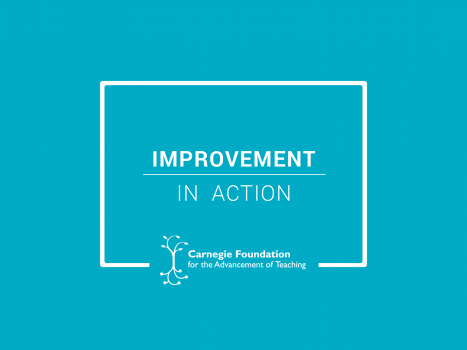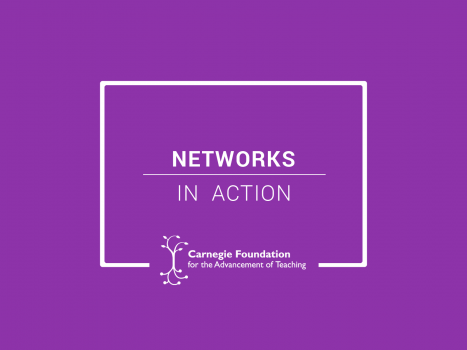In education, knowing what works, for whom, and under what conditions requires deep understanding of individuals — their needs, concerns, and motivations — as well as the contexts they inhabit. The very first of Carnegie’s Six Core Principles of Improvement is to make the work problem-centered and user-focused. In a school setting, users can include students, teachers, administrators, family members, and other youth-serving individuals. A user-centered strategy is premised on the notion that those who face the problem day-to-day are the ones who best understand it and, therefore, hold the keys to its answer; accordingly, a user-centered approach holds promise in creating democratic and desirable solutions that work in context and endure over time.
Tracing its roots in engineering fields such as computer science and ergonomics, user-centered design has several aspects congruent with the science of improvement. For instance, user-centered design encourages explicit understanding of users, tasks, and environments. A turning point in designing the Carnegie Math Pathways initiative, for example, occurred during interviews with students in college developmental math courses who identified the issues that hindered their success in these courses: they took too long to complete, the content had no relevance to their lives, and the students felt that they did not belong in these math courses or even in college.
We are witnessing how rapid demographic and technological changes have placed and will continue to place pressures and demands on our K-12 and postsecondary systems. The work of educators grows increasingly complex as they adapt instructional strategies and develop new capacities to meet the needs of an increasingly diverse student population. A range of improvement science techniques including process maps and empathy interviews aid our ability to take stock of the landscape and understand how people, processes, and tools operate in service of young people’s learning and development.
A user-centered strategy is premised on the notion that those who face the problem day-to-day are the ones who best understand it.
Consideration of the whole user experience is another key premise of user-centered design. We know that the work of teachers is embedded within larger complex social structures. Classrooms are situated within schools that have their own identity, culture, and climate issues. Schools, in turn, are embedded within districts focused on reform initiatives to meet accountability demands. And districts operate within communities wrestling with unique challenges — from poverty to crime to unemployment. We know how many urban systems are characterized by high turnover of leadership and staff that can impede the ability of stakeholders to scale and sustain change efforts. Therefore, taking into account the forces within each of these domains and how they interact to influence the work that happens inside classrooms is critical for improvement to occur.
To maintain a focus on human, in addition to technical, needs, user-centered design promotes active user participation throughout — from the analysis of the problem to the planning, development, testing, evaluation, and refinement of potential solutions. Whether they be youth, teachers, or parents, direct involvement of different types of users in identifying high-leverage problems and solutions promotes socially- and culturally-conscious systems. Listening to stakeholders, understanding where they are ready to invest effort, and affording them decision-making opportunities, create the conditions that nurture equity and meaningful engagement. For example, studies on the use of data in schools suggest that the attainment of goals increases when practitioners at the classroom, school, and district levels collaborate, rather than relying on isolated individual actions to be the primary determinant of outcomes and practices.
Finally, from a user-centered perspective, system change can often be iterative and incremental in nature. As such, continuous iterations based on user feedback and other measures of effectiveness are a crucial part of the process. Plan-Do-Study-Act (PDSA) cycles provide the scaffold for the small-scale, iterative development of changes. PDSAs enable rapid assessments and provide users with the flexibility to adapt efforts, responding to the improvement knowledge gained. While seemingly a simple and straightforward model, PDSAs are multifaceted, comprised of interdependent steps shaped by local circumstances.
User-centered design has garnered a lot of attention in recent years. Its utilization has been seen across a range of industries and sectors, including education. User-centered design is distinct from other problem-solving paradigms in that the questions, insights, and activities rely upon the perspectives of the people for whom the solution, system, or service is intended. Developing, testing, implementing, and spreading a change cannot happen without the support of people; moreover, focusing only on the changes themselves and not on their effect on people will doom most improvement efforts. Undoubtedly, improvement is a team sport and Carnegie’s networked improvement communities, which view educators as chief drivers of the change process, affirms the value of human work in helping all students learn across varied social, economic, political, and cultural circumstances.
February 3, 2017
Continuous improvement is gaining adherents in education for its evidence-based and structured methodology to creating lasting, effective changes to improve student achievement. Two Wisconsin superintendents share lessons learned as pioneers of the improvement process.
February 17, 2017
A networked improvement community in Tennessee that’s applying improvement science to address literacy rates finds that journey mapping helps to see the system more clearly, to build empathy for students affected by the problems, and to focus their improvement work.






